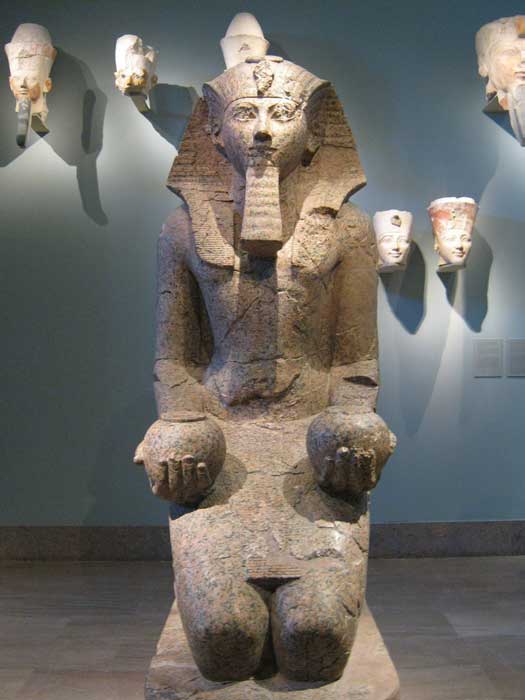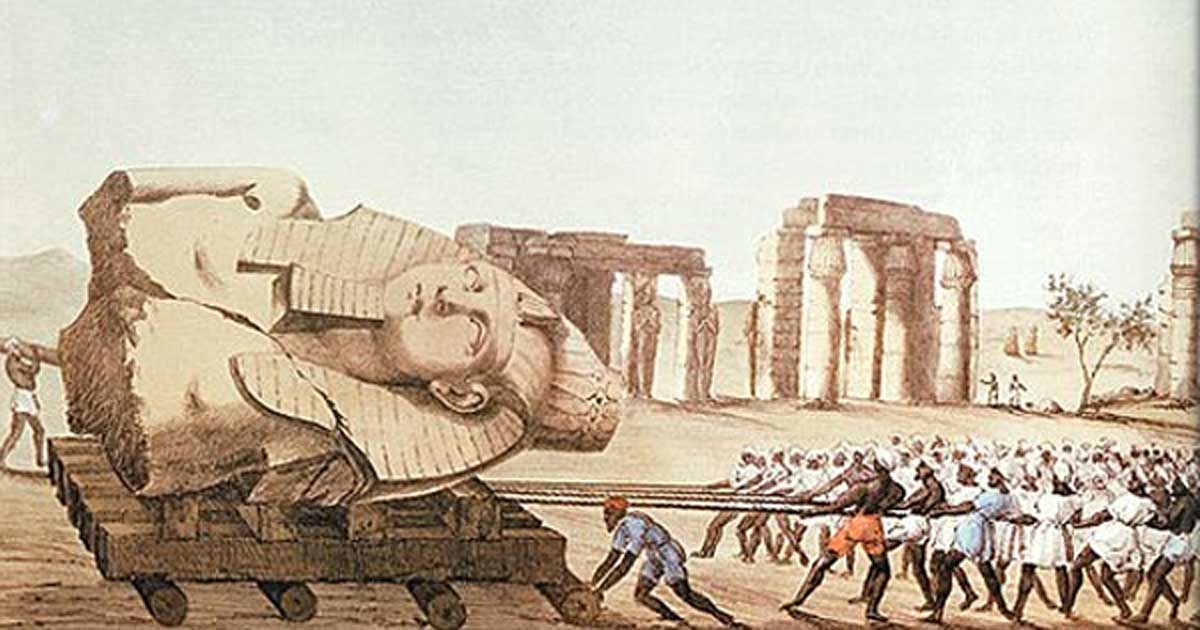KV20: The Famous Female Pharaoh Hatshepsut Has a Magnificent Temple, But What Became of Her Body?
Father and daughter, Tuthmose I and Hatshepsut were two famous pharaohs of the 18th dynasty of the New Kingdom of Egypt; Hatshepsut being only the second confirmed female pharaoh. KV20 is one of the most ancient known tomb sites of the Valley of the Kings, and possibly the first royal tomb to be constructed. Upon assessment of various pieces of evidence found within its walls, it is believed that this tomb was one possible burial site for the two pharaohs. However, as with many of the stories that are painstakingly revealed through archaeological investigation, the truth has been obscured by the various infiltrators over the centuries, be they successive pharaohs moving the mummies, rummaging looters, or even those with a genuine interest in discovering and preserving history. Bones and artifacts have been shifted from one tomb to another, creating a giant puzzle of evidence to be sorted - some parts being easier to piece together than others. And so, although much is known about Hatshepsut, the whereabouts of her body is still uncertain. Could the answer be buried in the story of the tomb that is KV20?
Succession of Visitors to Tomb KV20
As the sands of the desert revealed the entrance to the tomb, people began its exploration. Their curiosity, as well as greed for legendary treasures, pushed them to enter a place that was forbidden to the living. Although the tomb was looted centuries ago, the remarkable story held among the ancient walls blew the minds of dozens of researchers.
The tomb was well-known before the first team of scientists arrived in Egypt with Napoleon Bonaparte and started their exploration. They were aware that the tomb had already been looted, but the mystical experience of entering the ancient Egyptian tomb was irresistible. At that time, the history of ancient Egypt still had a magical flavor that drew European adventurers.

Panorama of the Valley of the Kings, looking north. By Nikola Smolenski. (CC BY-SA 3.0) KV20 is one of the most ancient known tomb sites of the Valley of the Kings.
After the exploration in 1799, the tomb was left practically unprotected for years. Almost two decades later, the Italian explorer and passionate amateur of Egyptian archaeology, Giovanni Battista Belzoni, arrived at the Valley of the Kings. Although enthusiastic, his knowledge of archaeological method would have been very limited and somewhat undisciplined. He treated the remarkable ancient sites like a huge theme park full of mysterious places that he could uncover from the sands of the desert. As such, he was less than meticulous in his documentation of his finds.
- More than 50 royal Egyptian mummies unearthed in Valley of the Kings
- Hatshepsut: The Queen who became King
- Many Royal Tombs Still Awaiting Discovery in Egypt's Valley of Kings

Giovanni Battista Belzoni, by William Brockedon. (Public Domain) He is one of many who entered KV20 when he arrived at the Valley of the Kings.
Later, in 1924, James Burton cleared the tomb as far as its first chamber. Moreover, the famous German researcher Lepsius explored KV20. But it was Howard Carter (of Tutankhamun’s tomb) who led the most serious works. At the time, he was the Inspector of the Antiquities Service and a report was also sponsored by one of the most prominent persons in early Egyptology – Theodore M. Davis. The report, related to the works at the Valley of the Kings, was published in 1906.
Tomb KV20 is located in the neighborhood of the ancient burials known as KV60, KV19, and KV43. Its burial chamber lies about 97 meters (318 ft.) beneath the surface. The tomb doesn’t follow the ancient architects’ conventional blueprints. It has an unusual shape consisting of five mysterious corridors, only two of which end with chambers. Sadly, most of the decoration had been lost, but there are still several links between its ancient greatness and the current damaged space.

Isometric, plan, and elevation images of KV20- taken from a 3d model. By R.F. Morgan. (CC BY-SA 3.0)
Nobody else showed much interest in the tomb until 1994. As it had been confirmed that there were no more treasures inside, the researchers focused on different findings. However, after the tragic flood in the Valley of the Kings, archaeologists and conservators turned their attention again towards the forgotten tomb.
Was KV20 the First Resting Place for Hatshepsut and Tuthmose I?
As mentioned, it is believed that KV20 originally belonged to Hatshepsut and Tuthmose I. Evidence suggests that KV20 was originally created for her father and then extended to accommodate Hatshepsut as well. However, both were reburied later and the mummy of Tuthmose was found in the Royal Mummy Cache in DB320. Thus, it is hard to identify much evidence related to the original burials. Most of the funeral equipment was lost and the state of the tomb suggests that the mummies were reburied due to the danger of looters. So, although there is much evidence of the significance of Hatshepsut when she was alive (the primary example being the glorious Temple of Hatshepsut at Deir el-Bahari) the lack of evidence for what happened to her after her death is conspicuous.
What became of Thutmose is less obscure. His body was moved to a second tomb, thought to be located in an entirely different part of the valley, in KV28. Nonetheless, the Thutmose’s mummy was discovered in the cache DB320, the famous tomb where the priests hid the bodies of the kings and queens of Egypt. In the case of Hatshepsut, although some researchers believe that they have identified the mummy of the female pharaoh, controversies are still evident.

Hatshepsut’s Temple, Deir el-Bahari, Luxor. (CC BY SA 3.0) It is believed the famous female pharaoh was originally buried in tomb KV20, however, her mummy hasn’t been found.
The most important artifact discovered in KV20 relates to Hatshepsut and strongly connects her to the tomb. At its entrance, Howard Carter found the single foundation deposit of the queen. It consisted of the fragmented remains of funerary furniture and some broken stone vessels with the names Tuthmose I, Ahmose-Nefertari, Ahmose, and Hatshepsut. The funerary equipment included a shabti figure of Hatshepsut, thus leading some researchers to believe that it could have been her former burial place. Nicholas Reeves and Richard H. Wilkinson in their work ''The Complete Valley of the Kings'' wrote that this is the only known shabti of Hatshepsut. The notes by the researchers claim that the fragments of at least one coffin had been discovered. It is believed that the anthropoid coffin belonged to her.
- Ancient Egyptians implemented flood control systems to protect tombs
- DB320 - Uncovering the Impressive Cache of Hidden Pharaohs
- Archaeologists identify Temple of Hatshepsut, the female Pharaoh the ancients tried to erase

One of the two sarcophagi found in KV20, originally intended for Hatshepsut, but re-inscribed for her father Thutmose I. By Keith Schengili-Roberts. (CC BY-SA 2.5)
The Missing Pharaoh from KV20 Remains a Mystery
The absence of a confirmed body maintains the mystery surrounding the burial and subsequent movement of Queen (or rather Pharaoh) Hatshepsut. Although inconclusive, investigators do have evidence to form some hypotheses. A mummified liver or spleen and a molar contained in an ivory coffer bearing her name was found in a location other than KV20. In 1903, Howard Carter uncovered KV60, which contained two female mummies, one identified as Hatshepsut’s wet-nurse but the other was unidentified. The unidentified body was missing a tooth and the space matched the molar discovered in the ivory coffer bearing her name.

Hatshepsut offering new jars, red granite sculpture at the Metropolitan Museum of Art, New York City. By Postdlf. (CC BY- SA 3.0)
Another possible place for her burial is located on the cliff near the Valley of the Kings. It was discovered by Howard Carter, who described the situation:
''It was midnight when we arrived on the scene, and the guide pointed out to me the end of a rope which dangled sheer down the face of a cliff. Listening, we could hear the robbers actually at work... When I reached the bottom, there was an awkward moment or two. I gave them the alternative of the clearing out using my rope, or else of staying where they were without a rope at all. Eventually they saw reason and departed.''

Large kneeling statue of Hatshepsut, by Peter Roan. (CC BY NC 2.0)
The now damaged and looted KV20 isn't an impressive or even well-known tomb. Its former glory has suffered by the assaults of time, sand, humanity, and flooding - leaving it almost forgotten. However, the small pieces of the puzzle found there, which became a part of a museum exhibition, remind us that the tomb was probably the original burial place for two impressive people, whose reigns changed the history of the fascinating empire built near the Nile River.
Top Image: An artist’s representation of Giovanni Battista Belzoni’s expedition. Belzoni is one of many researchers who entered the tomb KV20. Source: Public Domain
References:
Nicholas Reeves and Richard H. Wilkinson, The Complete Valley of the Kings, 2008.
KV 20, available at: http://www.thebanmappingproject.com/sites/browse_tomb_834.html
KV 20, available at: www.narmer.pl/kv/kv20en.htm
Valley of the Sun Kings by Richard H. Wilkinson, available at: http://www.ltrr.arizona.edu/~pcreasman/UAEEfiles/VSK.pdf
















